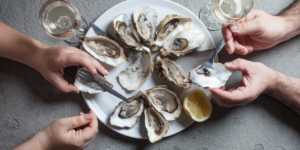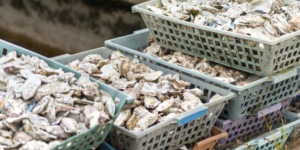The taste of oysters is a complex interplay of various factors, and their unique flavor is influenced by both intrinsic and extrinsic elements.

Oysters are filter-feeding bivalve mollusks that take on the characteristics of their environment, resulting in diverse flavor profiles based on their habitat. Several key factors contribute to the taste of oysters:
Species
Different species of oysters have distinct taste profiles. For example, Pacific oysters (Crassostrea gigas) are generally described as briny and cucumber-like, while Eastern oysters (Crassostrea virginica) are known for their buttery and salty taste. Each species has its unique balance of minerals and compounds that contribute to their flavor.
Location and Environment
The “merroir” (marine equivalent of “terroir”) plays a crucial role in oyster flavor. Oysters take on the characteristics of the water they inhabit, including the salinity, mineral content, and the presence of phytoplankton and algae. Oysters from different regions or bodies of water can exhibit significant variations in taste.
Salinity
Oysters thrive in estuarine environments where freshwater and saltwater mix. The salinity of the water significantly affects their taste. Oysters from areas with higher salinity tend to have a more briny and intense flavor.
Temperature
Water temperature can influence the metabolism and feeding activity of oysters, impacting their growth and flavor. Warm waters may result in faster growth but could lead to a milder taste compared to oysters from colder regions.

Feeding Patterns
Oysters are filter feeders, consuming plankton and other particles from the water. The type and abundance of phytoplankton and algae present in their environment can affect the oysters’ flavor by influencing the compounds they assimilate.
Maturation Time
Oysters continue to develop and mature in flavor throughout their lifespan. Generally, the longer an oyster is left to grow, the more pronounced its taste becomes.
Harvesting Season
Oyster taste can vary with the time of year. For example, oysters harvested during the colder months might have a different taste compared to those harvested in warmer seasons.
Preparation and Presentation
Culinary techniques also influence how oysters taste. Raw oysters, for instance, are prized for their fresh and briny flavors, while cooked oysters may have different taste profiles depending on the method used (grilled, steamed, fried, etc.).
Storage and Transportation
Proper handling, storage, and transportation of oysters are crucial to preserving their taste and quality. Temperature fluctuations and exposure to air can impact their flavor negatively.
In summary, the taste of oysters is a result of a combination of factors, including species, location, salinity, water temperature, feeding patterns, maturation time, harvesting season, and preparation methods. Understanding these elements and their interactions contributes to the appreciation of the unique and diverse flavors that oysters can offer.



